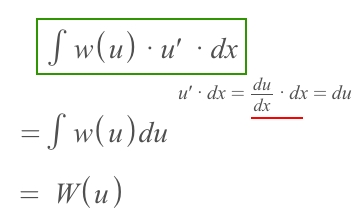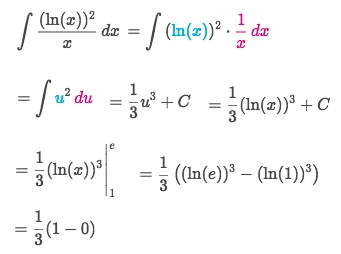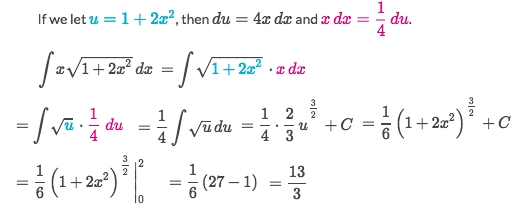U-substitution → Chain Rule
The
u-substitutionis to solve an integral of composite function, which is actually to UNDO theChain Rule.
▶ Back to previous note on: Chain Rule
Compare how we handle the composite functions with derivatives & integrals:
For taking the derivative of a COMPOSITE function, we apply the
Chain rule.For taking the integral of a COMPOSITE function, we apply the
u-substitution.
Refer to Khan academy: 𝘶-substitution: defining 𝘶
We use u-substitution when we need to integrate an expression of the form of: 
Strategy:
Find a function as
uFind or MAKE an
u'at the outside so that you can pairu'withdxReplace
u' · dxwithdu, becauseu' = du/dxRewrite the Integral in term of
u, and calculate the integralBack substitute the function of
uback to the result.

How to select u
Selecting u is the most tricky part here.
Example
 Solve:
Solve:
Apparently, we ignore the wrapper
sin()here.We notice that the derivative of
-x+2is-1which we could find it at outside.So let
u = -x+2andu' = -1So rewrite the integral to
ʃ sin(u) · u' · dx = ʃ sin(u) · duIt looks quite neat, so the
u = -x+2is alright.
Example
 Solve:
Solve:
Apparently it's in form of
ʃ u'/u · dxSo that we can make
u'·dx = duand the integral becomesʃ 1/u · duQuite nice, so the answer would be out of there.
How to calculate Indefinite Integral with u-substitution
Example
 Solve:
Solve:
With a real quick eyeballing, we see it's in form of
ʃ u' · u⁶ · dxSo with
u' · dx = duwe will get the simplified formʃ u⁶ · du = u⁷/7Back substitute function of u back to get the result:

How to calculate Definite Integral with u-substitution
Example
 Solve:
Solve: 
Example (self-made u')
 Solve:
Solve: 
Example (Inverse Trig Rule)
 Solve:
Solve:
Notice this radical form should directly use the Reversed Inverse Trig Rule:

So that we assume
a = 1 & u = 3x.Since
u' = 3so we need to make a3from nowhere.Rewrite the formula to:
1/3 ʃ 3/(1+u²) ·dx = 1/3 ʃ 1/(1+u²) ·duApply the Reversed Inverse Trig Rule to get:
1/3 arctan(u) + CBack substitute
3xtouand the boundaries back toxget the resultπ/6.
Last updated